Right-Sizing Your Deep Hole Boring Solution
Deep hole boring comes with challenges created by the inevitable deflection that occurs when trying to finish a hole of a substantial depth. Various factors determine the best approach to solving the issue, and it’s important to consider all factors before choosing a solution for your boring needs.
Finishing and semi-finishing – the difference in tooling
As in any cutting application, the tool has to match the purpose of the cut. In small diameter applications, heavy metal bars with modular connections are ideal to use for deep hole semi-finishing. Heavy metal is denser than steel to offer better vibration-damping, but it is tougher than sintered carbide, so the tool can handle higher cutting forces. Since semi-finishing is usually performed by twin-cutting, the reduction in bar stiffness is overcome by the fact that the cutting forces are balanced from the twin boring head.
The more substantial challenge for deep-hole boring of smaller diameters is during finishing. Finish boring is typically a single-point operation, so a sintered carbide bar works better here because it is stiffer, and less likely to deflect. Deflection not only causes errors in bore size but can also lead to poor surface finish.
Maintaining rigidity
Whenever you cut a part, the tool exerts force on the part. The corollary of that is that the part will also exert a force back on the tool, and the longer the tool the more that force can affect the performance of the tool. You are always going to get some kind of deflection. Sometimes it is measurable, sometimes it isn’t, but it really gets magnified when you have a tool that extends six- or eight-times diameter.
What is crucial in any boring process is to establish as much rigidity as possible in the shank. The best way to ensure that in a standard application is to avoid having too many connections between the taper and the cutting head. For instance, if you are using a modular system to achieve extension, the fewer parts included the better. BIG Kaiser has a semi-modular system that includes extended-length shanks so that companies that have high volume production can more easily change out tools while maintaining good rigidity in the cut. If there were more than one component making up the shank, rigidity is inevitably compromised.
However, in some cases this single-shank approach won’t work because the tool can become too heavy. The extra mass of a tool helps cutting processes in smaller diameters, acting as a stabilizer. However, it is hard to maintain that value once you get over a certain diameter connection. At some stage, the tool just becomes too heavy for operators and ATC’s (automatic tool-changers) to handle. There are solutions now that use lighter materials to offset this challenge. In BIG Kaiser’s case, the company has created aluminum components in a modular system that introduces vibration damping properties to the tool. What this solution loses in stiffness it gains in vibration dampening properties.
The solution, known as a CKN tool, is a three-screw connection, where the three piloted screws in the aluminum tube engage in the slotted pilot part of the connection, and expand it to get both cylindrical and face contact. This solution is used often in applications of 3-inch diameters and greater, up to 24”. It can reduce the weight of the tool by 50 percent, making it easier to handle.
Damper systems
For length-to-diameter ratios between four- and eight -to-one in intermediate diameter ranges, special application tools are often required for finishing because it is difficult to control vibrations, or to get the balance between lightweight components and stability. BIG Kaiser has introduced the Smart Damper system for this type of finishing application. Offered in integral shank and modular extension types, these damped holders are specifically designed to reduce chatter when paired with Kaiser finish boring heads.
Sometimes, the introduction of Smart Damper components means the difference between boring success and failure. In other cases, the use of the damper allows you to run parts faster. In tests that BIG Kaiser’s parent company, BIG Daishowa, carried out in their facility, it was determined that running a tool with an .008” nose radius and the damping system in place, they were able to run good bores from 150 up to 1,300 surface footage, boring holes with a 6:1 ratio.
Bore depth vs. bore reach
It is important to consider the nature of the bore you are working on, and how much has to be cut from it. For instance, often a customer will say that he needs a two-inch diameter bore, and he needs the tool to be 10 inches long. But the next question to ask is, how deep is the two-inch bore? Do you need to bore the entire 10 inches, or do you need to reach out eight inches and just bore the last two. That changes the approach to the cut completely.
For instance, if you observe the illustration here, the length of the tool required is 7.1 in. on a diameter of 1.22. Using a dedicated tool creates a length to diameter ratio of 5.8 : 1. Anything at or above a 4 : 1 ratio is when you are likely going to see challenges with stability. However, because only a short section actually has to be bored, it is possible to use a modular application to reduce that length to diameter ratio. In this application, it was possible to reduce the ratio to 2.6 : 1.
Extra-long length solutions
In special cases, where you have a very large diameter and substantial depth, none of these solutions is practical. In these cases, a guide bushing can be put around the tool. As its name implies, it serves to guide the tool in the hole and keeps it from bouncing around. It is a specialized application, but if done properly can help a standard tool work as well.
The challenge with guide bushings is that you have to run them very slowly and pay very close attention to your spindle loads to make sure that chips don’t jam up the ring, because that will ruin the finish. At around 20 inches in length for 3-inch diameter bores and up is when it is suggested to consider this type of solution. If it were a 1.5-inch bore, it would be worth considering this type of solution at 12 or 15 inch depths. It is advisable to discuss your options with your tooling provider.
Boring head management
Another key consideration in preparing your deep-hole bore is ensuring that you have a properly balanced boring bar. Most modular components used to build up a tool assembly are already pre-balanced, but this means little if the boring head is not balanced as well. Today, there are multiple options for balanceable and even auto-balance boring heads. Many people look at balanced boring heads and think that they are only for high-speed applications, but in long-reach applications, the balanced boring head eliminates another force that could cause trouble in the extended-length assembly.
Insert selection
When calculating how much stock to leave for finishing deep bores, remember that less is better. Lighter depths of cut reduce the force back on the tool, creating more stable cutting conditions. The limiting factor is the insert nose radius on the boring bar. Typically, you want to look at using an .008” nose radius on the insert, so you would aim to leave .008-.010” stock on the diameter. That is fairly standard. Larger diameter applications may permit a shift up to a .016” radius, so it is worth discussing this with your tooling provider.
The ideal insert selection is going to be a ground insert that has a sharp cutting edge to cut more freely. This not only helps reduce the tool pressure, but ensures that the chips remain short and can be effectively evacuated from the bore – a critical requirement to maintain size and finish control in deep bores.
Getting the right finish on a bore can be a delicate process, but advancements in tooling have created many different approaches to help you get the finish necessary to keep customers satisfied. Your cutting tool provider is there to help manage your solution as well, so be sure to ask which of these solutions might be the one for your particular project.

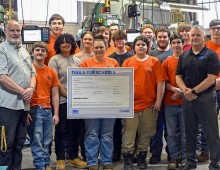


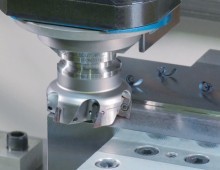
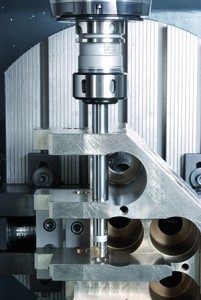
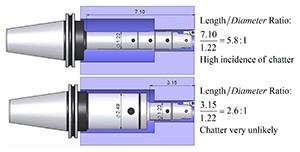
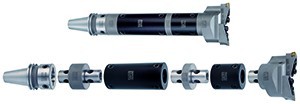
¿Te pareció interesante o útil? Haznos saber tu opinión agregando tus comentarios o preguntas a continuación.